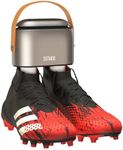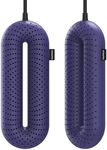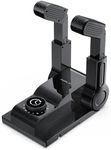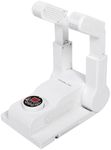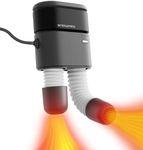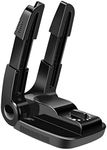Buying Guide for the Best Boot Dryers
Choosing the right boot dryer can make a significant difference in maintaining the longevity of your footwear and ensuring your comfort. Boot dryers are designed to remove moisture from your boots, which helps prevent the growth of bacteria and mold, and keeps your feet dry and warm. When selecting a boot dryer, consider the following key specifications to find the best fit for your needs.Drying MethodThe drying method refers to how the boot dryer removes moisture from your boots. There are mainly two types: convection and forced air. Convection dryers use natural air circulation and heat to dry boots, which is gentle and quiet but can take longer. Forced air dryers use fans to blow warm air into the boots, drying them faster but potentially being noisier. If you need quick drying, especially for frequent use, a forced air dryer might be better. For overnight drying or less frequent use, a convection dryer could be sufficient.
Drying TimeDrying time is the duration it takes for the boot dryer to completely dry your boots. This can range from a few hours to overnight. Faster drying times are convenient if you need to use your boots multiple times a day or if you live in a particularly wet climate. However, if you usually dry your boots overnight, a longer drying time might not be an issue. Consider your routine and how quickly you need your boots to be ready when choosing the drying time.
CapacityCapacity refers to how many boots or pairs of boots the dryer can handle at once. Some dryers are designed for a single pair, while others can accommodate multiple pairs or even other gear like gloves. If you have a large family or multiple pairs of boots that need drying simultaneously, a higher capacity dryer will be more efficient. For individual use or occasional drying, a single-pair dryer might be sufficient.
PortabilityPortability is about how easy it is to move and store the boot dryer. Some models are compact and lightweight, making them ideal for travel or for use in different locations. Others are larger and more stationary, suitable for a dedicated drying area at home. If you need a dryer that you can take on trips or move around frequently, look for a portable model. If you have a fixed spot for drying your boots, a larger, more robust model might be preferable.
Noise LevelNoise level is the amount of sound the boot dryer produces while in operation. Forced air dryers tend to be noisier due to the fans, while convection dryers are generally quieter. If you plan to use the dryer in a shared or quiet space, a lower noise level might be important. For use in a garage or a less noise-sensitive area, the noise level might be less of a concern. Consider where and when you will be using the dryer to determine the acceptable noise level.
Temperature ControlTemperature control allows you to adjust the heat level used to dry your boots. Some materials, like leather, can be damaged by high heat, so having the ability to control the temperature can help protect your boots. If you have a variety of boot materials, look for a dryer with adjustable temperature settings. For more rugged, heat-resistant boots, this feature might be less critical.
Additional FeaturesAdditional features can include things like timers, ozone generators for deodorizing, and UV light for sanitizing. These features can add convenience and extra functionality to your boot dryer. If you are looking for more than just drying, such as eliminating odors or bacteria, consider a model with these additional features. If basic drying is all you need, a simpler model without these extras might be more cost-effective.
